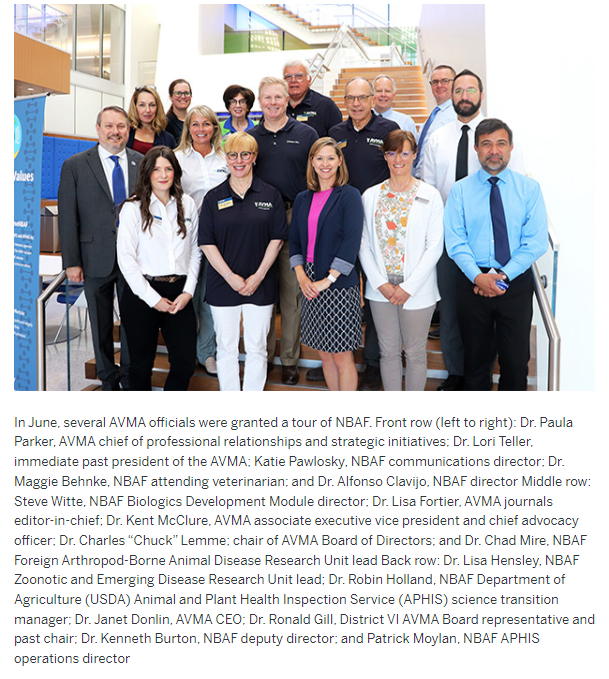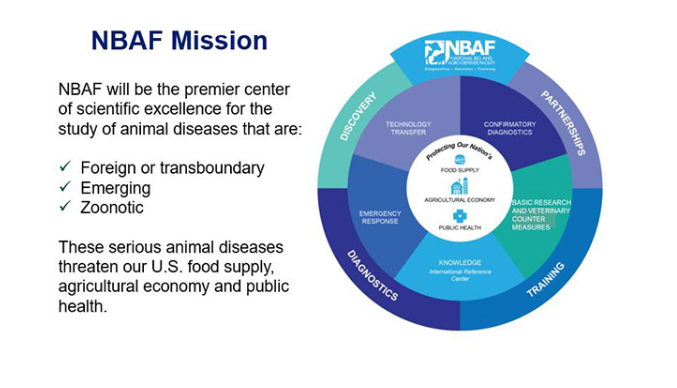A research facility ahead of its time

A research facility ahead of its time
AVMA News

Government officials and representatives of the livestock and animal health industries gathered together this past May in Manhattan, Kansas. They were there to celebrate the collaboration between the Department of Homeland Security (DHS) and the Department of Agriculture (USDA) in opening the National Bio and Agro-Defense Facility (NBAF), arguably the most advanced animal agriculture research and diagnostics center ever created.
Nearly 20 years in the works, the $1.25 billion facility will ultimately replace the Plum Island Animal Disease Center where, for more than half a century, USDA scientists led efforts to protect the nation from foot-and-mouth disease and other devastating foreign animal diseases (FADs), such as African swine fever (ASF) and classical swine fever.
Nearly 20 million Americans—or roughly 10% of all the workers in this county—owe their employment to agriculture, either directly or indirectly, said Agriculture Secretary Tom Vilsack at the opening event.
“One out of every 10 connected to agriculture, so to the extent that we can protect it, we can protect its ability to produce and produce safely,” he said. “We are not just talking about food supply and the national security implications of that, we are also talking about economic security.” The National Bio and Agro-Defense Facility (NBAF), located in Manhattan, Kansas, is operated by the U.S. Department of Agriculture (USDA) and situated in proximity to the highest concentration of animal health organizations in the world, according to the agency. NBAF will host diagnostics and training as well as research and development of veterinary countermeasures—such as vaccines and antivirals—for foreign, emerging, and zoonotic diseases in livestock within the safety and security of this next-generation facility. (Photos courtesy of NBAF)
In June, several AVMA officials were granted a tour of NBAF, which is normally closed to the public. They learned about the plans for staffing, diagnostic and vaccine banks, and research capabilities, including two new units assigned to look at foreign animal diseases transmitted by arthropods and zoonotic and emerging pathogens in livestock.
Dr. Ronald Gill, 2022-23 chair of the AVMA Board of Directors and District VI representative said the tour was an extremely impressive experience. “The individuals working there are very proud of the facility and their part in the design, development, and building of the massive building,” he said. With information provided by the USDA, AVMA News takes a look at the past, present, and future state of animal disease research directed by the federal government.
Laboratory facilities
The DHS assumed responsibility for Plum Island from the USDA in 2003. Two years later, the department warned that the facility was in danger of becoming outdated. So, it announced plans to build a state-of-the-art laboratory facility in the nation’s heartland capable of supporting increasing levels of research and development to meet concerns about the accidental or intentional introduction of foreign animal diseases.
“Through cutting edge research, diagnostics, and training, NBAF is a critical component of USDA’s priority to protect livestock, the agricultural economy, and even public health from emerging, transboundary animal and zoonotic diseases,” said NBAF Director Dr. Alfonso Clavijo.
Manhattan, Kansas, was deemed the ideal location for the new facility for several reasons. In addition to its proximity to livestock research and the available workforce, NBAF is adjacent to a large land-grant university with a veterinary college—Kansas State University. It is also located on the western edge of the Animal Health Corridor, which has the highest concentration of animal health companies in the nation.
Given his background in food and large animal medicine, Dr. Gill said he initially was concerned about NBAF’s location “in the middle of one of the most concentrated cattle feeding areas of the country.” His issues with the facility’s location were allayed after having seen the many layers of security in place at NBAF.

“I am sure that some will be forever concerned about this facility being placed in Manhattan, Kansas, but I feel much better about the security we witnessed and the devotion to duty the employees demonstrated,” Dr. Gill said.
Over the years, the AVMA has helped raise awareness among members of Congress and their staffs about the need for the new NBAF and the many ways it would defend against the growing threat of new and emerging infectious animal disease.
The transfer of science programs from Plum Island to NBAF will occur in phases over the next few years. NBAF must first go through select agent registration and other necessary clearance processes before it will be ready to transition all Plum Island science activities. That registration process is estimated to be complete by mid- to late 2024. The USDA will own and operate the 48-acre NBAF campus, where more than 400 employees with USDA’s Agricultural Research Service (ARS) and Animal and Plant Health Inspection Service (APHIS) will work. The facility is equipped with a wastewater pretreatment plant, animal holding areas, and biosafety level-2 (BSL-2), -3, and -4 laboratories.
The BSL-4 capabilities at NBAF are vital to its mission as only a handful of facilities in the world have BSL-4 space capable of housing livestock. NBAF scientists and researchers will have access to modern facilities and diagnostic tools for animal disease surveillance, training animal disease first responders, and vaccine research and development for FAD control and eradication.
New research units
The USDA is establishing two new research units at NBAF: the Foreign Arthropod-Borne Animal Disease Research Unit (FABADRU) and the Zoonotic and Emerging Disease Research Unit (ZEDRU). Using NBAF’s insectary, FABADRU will focus on creating intervention strategies for foreign animal diseases transmitted by arthropods, such as Rift Valley fever and Japanese encephalitis virus, both transmitted by mosquitoes. NBAF will have the capacity to house insects for studies in high containment.
This is an important new capacity considering that many of the newly emerging diseases, including ehrlichiosis and babesiosis, are transmitted by insects such as mosquitoes and ticks. For the first time in the U.S., this space will allow scientists the opportunity to study these high-consequence diseases in the vector as well as in the host and conduct transmission studies, which will result in novel control solutions.
ZEDRU will focus on combating zoonotic and emerging pathogens in large livestock. This is something USDA scientists cannot do anywhere else in the U.S. in a BSL-4 setting. These diseases include the tick-borne Crimean-Congo hemorrhagic fever virus and Nipah virus, which causes encephalitis and respiratory illness in pigs and people.
Another USDA first is NBAF’s Biologics Development Module (BDM). It is a proof-of-concept facility that will take NBAF’s basic research and translate it into applied science such as vaccines and other disease countermeasures.
The BDM will collaborate with industry partners to transfer research into veterinary medical countermeasures used to prevent or fight animal disease outbreaks around the world. It will focus efforts on the early research to early development phases of research, performing proof-of-concept studies for safety and efficacy, while scaling up processes and developing analytical tools for project support.

Future of One Health
Dr. Janet Donlin, CEO of the AVMA, said the entire facility is a testament to the brilliance and dedication of the visionary people at the USDA and DHS, and the many other researchers and clinicians who devote their lives to protecting the health and welfare of animals and humans.
“We tremendously value our wonderful relationships with the USDA and DHS as we work together to advance science and medicine, and I am confident that pioneering discoveries at NBAF will be at the forefront of efforts demonstrating the importance and value of One Health,” Dr. Donlin said. “Approximately 75% of new or emerging infectious diseases have originated in animals before infecting humans. The NBAF mission reinforces the important role veterinarians and cross disciple collaborations play in One Health, and the scientific and logistic innovations being developed at NBAF for early disease detection and rapid mitigation if needed was truly impressive.”
